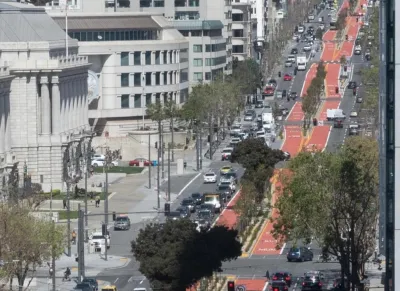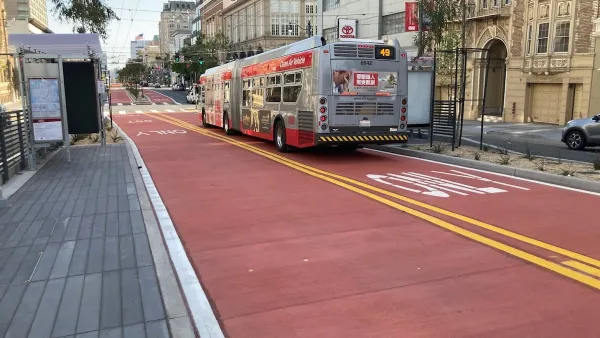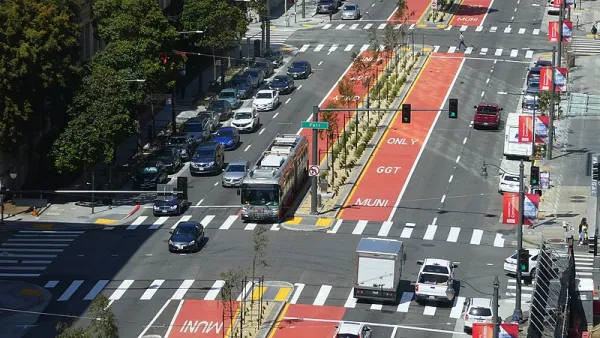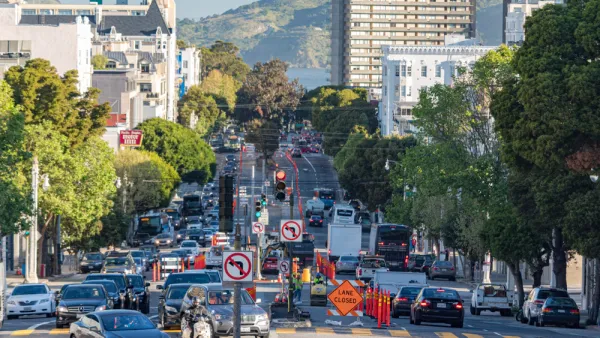After a month of service, the Van Ness BRT line has cut travel times by roughly nine minutes and spurred increased ridership.

The highly anticipated Van Ness Bus Rapid Transit project in San Francisco, which opened a month ago, is successfully cutting travel times and attracting 13 percent more riders, reports Ricardo Cano. “Northbound weekday trips on the BRT lanes are also saving riders 35% in travel times, according to the agency, meaning that it takes Muni buses about nine minutes fewer to travel on the corridor than it did before the BRT project.”
According to Cano, “Before the pandemic, it would take 49 buses 50 minutes, round trip, to complete a run between stops at Mission and 13th streets and Van Ness and Chestnut Street. Now, buses completing that same trip are doing so in about 36 minutes on weekday mornings, shaving off 14 minutes from travel times, agency data show.” In the future, “The BRT lanes are expected to bring more travel time savings as the agency optimizes the transit signal priority that help buses progress through intersections on the corridor faster. ”
Meanwhile, the agency is struggling to bring back pre-pandemic service levels. “Frustrated transit advocates have wanted SFMTA to act faster to restore suspended lines and add frequencies to current lines, though the agency has said an operator shortage has hampered progress.”
FULL STORY: CA: One month after its debut, this is how S.F.'s Van Ness BRT is performing

National Parks Layoffs Will Cause Communities to Lose Billions
Thousands of essential park workers were laid off this week, just before the busy spring break season.

Retro-silient?: America’s First “Eco-burb,” The Woodlands Turns 50
A master-planned community north of Houston offers lessons on green infrastructure and resilient design, but falls short of its founder’s lofty affordability and walkability goals.

Delivering for America Plan Will Downgrade Mail Service in at Least 49.5 Percent of Zip Codes
Republican and Democrat lawmakers criticize the plan for its disproportionate negative impact on rural communities.

Test News Post 1
This is a summary

Test News Headline 46
Test for the image on the front page.

Balancing Bombs and Butterflies: How the National Guard Protects a Rare Species
The National Guard at Fort Indiantown Gap uses GIS technology and land management strategies to balance military training with conservation efforts, ensuring the survival of the rare eastern regal fritillary butterfly.
Urban Design for Planners 1: Software Tools
This six-course series explores essential urban design concepts using open source software and equips planners with the tools they need to participate fully in the urban design process.
Planning for Universal Design
Learn the tools for implementing Universal Design in planning regulations.
EMC Planning Group, Inc.
Planetizen
Planetizen
Mpact (formerly Rail~Volution)
Great Falls Development Authority, Inc.
HUDs Office of Policy Development and Research
NYU Wagner Graduate School of Public Service





























